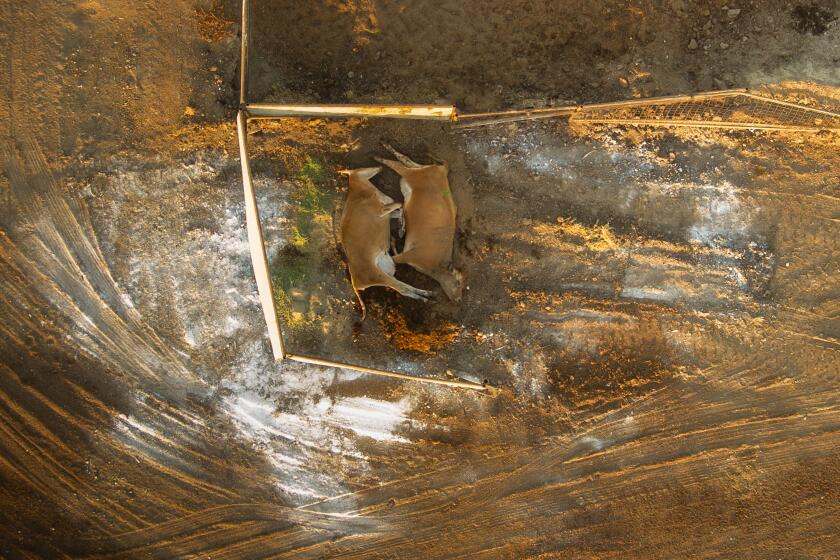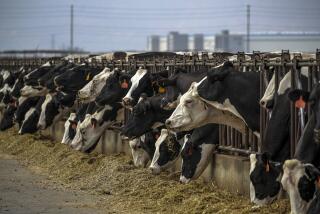
- Share via
TIPTON, Calif. — It was a late fall morning and hundreds of cows — black and white splattered Holsteins and cappuccino-colored Jerseys — milled about a San Joaquin Valley dairy farm in the largest milk-producing state in the nation.
Nearby, workers herded some of the animals onto a rotating platform within the farm’s milking parlor and quickly attached pumping equipment. The machines buzzed and whirred as the cows were carried in a lazy arc to the parlor’s exit, where they were detached from milk hoses and sent on their way.
The scene seemed utterly unremarkable — except for the fact that five days earlier, the H5N1 bird flu virus that has ravaged California’s dairy herds for the last three months had been confirmed on the farm. Although dozens of cows were sick, and their owner expected that number to climb, none of the farm’s workers wore personal protective equipment and vehicles from off site were let in and out with nary a hint of concern.

The farm was just one of more than 400 California operations that have been confirmed to have suffered outbreaks of H5N1, but interviews with Central Valley dairy farmers, dairy workers and a recent study by the U.S. Centers for Disease Control and Prevention suggest the virus may be more widespread in people than the CDC’s official numbers suggest. Although authorities have been urging dairy farms and workers to take precautions against spreading infection, there is little evidence their cautions are being heeded.
No expert will say that H5N1 bird flu is going to become the next global pandemic, and government health officers say the virus poses a low risk to the public. However, some experts warn that nearly all the conditions needed for the virus to develop a threatening mutation are now present in many dairy farms: lax testing protocols; close, unprotected contact between humans and animals; a general failure to take the threat seriously enough; and the approach of human flu season.
Bird flu virus was detected in a retail sample of raw milk from Fresno-based dairy Raw Farm, California health officials said.
Since this particular clade of H5N1 virus (2.3.4.4b) first appeared in North America at the end of 2021, it has infected more than 600 dairy herds across 15 states, hundreds of millions of wild and domesticated birds, and at least 48 mammal species — such as dolphins, seals, cats and dogs.
“We are in a soup of virus. I mean, there’s virus everywhere around us at this point,” Dr. Marcela Uhart, a wildlife veterinarian with UC Davis’ One Health Institute who is based in Argentina, said at a symposium held by the O’Neill Institute at Georgetown Law recently. “This virus is circulating left and right in mammals and in birds, as far as we can tell, some of them are not showing any signs of disease.”
In October, The Times visited Tipton, a dairy town in Tulare County, and spoke with several residents, including Elodia Ibañez, who said the number of reported human cases in California — which in mid-October was 16, and is now 29 — sounded too low. She said her husband, a dairy worker, told her that two of his co-workers had red, swollen eyes, but they had continued working despite displaying bird flu symptoms.
“It’s an illness that they know the cows have, and many cows have died. But the boss cared about the cows, not the workers,” Ibañez told The Times. “They never told them they have to go to the doctor to get a check-up.”
People often continue to work because they feel they have no other choice, she said. “Even though they say there are laws that protect them, there are still a lot of people who are fearful. … They’re scared of losing their jobs.”
Anthony, also a Tipton resident, said he would talk but did not want to share his last name; he has family members who work in dairies, and he feared impacting their employment by speaking out.
“My dad and uncle have told me there’s a bunch of dairies that have had outbreaks,” Anthony said. He said his dad and uncle take steps to stay safe, but many workers likely are not reporting getting sick because they don’t want to get in trouble.
“Some of them are here not legally. They’re relying on that job, they don’t want to jeopardize that,” he said.
In early November, the CDC published a study that looked for H5N1 antibodies in the blood of dairy workers in Michigan and Colorado. The agency sampled blood from 115 people; eight — or 7% — had antibodies. Only three dairy workers in those two states — one in Colorado, two in Michigan — have been positively identified as having the disease.
It’s this blindness to — and ignorance of — the virus’ reach that has infectious disease and health experts concerned.
And as human flu season approaches, and infected wild birds continue their southward migration down the North American flyways — stopping to rest in lakes, ponds, farms and backyards throughout the United States — experts worry conditions are becomingly increasingly ripe for a large “spillover” event.
Although California dairy farmers had heard about the H5N1 bird flu before it hit, none was prepared for the devastation it would cause in some herds.
If a virus — whether it’s a bird flu, a human influenza virus or a coronavirus — is given the opportunity to spread within and between organisms, the virus will evolve, adapt and mutate. Sometimes these mutations have little effect on its ability to transmit between organisms or cause severe disease. But sometimes, they do.
Then there’s the concern that the bird flu virus will find another flu virus that’s circulating — a human, swine or even other bird flu — and swap genetic material with it, potentially creating a new “super flu” that can spread easily between people, make its hosts very sick, or carry immunity to the antiviral medications used to treat infected patients.
In the 1970s, when the understanding of flu viruses was still being developed, Robert Webster, a researcher at St. Jude’s Hospital in Memphis, Tenn., conducted an experiment at the U.S. Department of Agriculture’s Plum Island Research Station, off the coast of Long Island.
He put a human flu virus — H3N2 — into one pig, and a swine flu virus — H1N1 — into another. He then put the two pigs in a pen with four other pigs. Seven days later, he and his team detected reassorted viruses — H3N1 and H1N2 — in one of the other pigs.
The viruses had swapped genes and created new combinations.

The work of Webster and others led to the discovery that several of the nastier historical flu pandemics have been the result of this kind of reassortment. For instance, the 1918 flu outbreak — which killed approximately 50 million people worldwide — is believed to have been a recombined version of a bird and human flu.
It happened again in 2009, when a human and swine flu switched genes, unleashing the H1N1 swine flu outbreak that killed roughly 500,000 people.
Already there is evidence this virus is swapping genes. The birds currently traveling south from the Arctic are carrying a slightly different variant of H5N1 — called D1.1 or D1.2 — that has an altered take on several of the flu’s viral segments.
It’s this strain that has put a Canadian teenager into critical condition at a British Columbia hospital. Health authorities don’t know where or how the child picked it up, except to note it wasn’t from cows or poultry. And they don’t know yet whether it has acquired the ability to move easily between people — although early and initial testing suggests it may have acquired some new and ominous traits, including changes that would make it easier to infect people.
Even so, as of this moment, there is no evidence that the H5N1 bird flu circulating among dairy cows and workers — known as B3.13 — has achieved the ability to move efficiently from human to human, or to cause severe illness. But with human flu season approaching — and the possibility that retail customers were drinking infected raw milk — the chances increase.
Although California dairy farmers anticipated a bird flu mortality rate of less than 2%, some say between 10% and 15% of infected cattle are dying.
In an effort to spread awareness among dairy farms and potentially lure workers in for testing and decrease the chances for this virus to acquire mutations that could make it widespread and deadly in people, state health, agriculture and workers safety experts held a workshop at the Tulare Expo Center in late October, with help from the dairy trade group Western United Dairies.
About 20 dairy workers and farmers sat through the two-hour session, which included English and Spanish presentations from the different state agencies and dozens of slides.
Dr. Erica Pan, California’s state epidemiologist, told the audience her agency recommended personal protective equipment at work, and urged people to protect their eyes. She also told the audience to stay up to date on their recommended vaccines and refrain from consuming raw milk and undercooked beef, “especially ground beef.”
Eric Berg, deputy chief of health and research and standards at CalOSHA, said that farms under quarantine needed to establish restricted areas for infected animals. Workers, he said, should wear protective clothing, including coveralls, gloves and “ very important ... eye protection and also respirators indoors.”
Eduardo Mondragon sat near the front of a conference room, nodding along as experts discussed safety protocols for dairy workers. As a manager of multiple dairy farms, Mondragon had watched the bird flu rip through the farms he oversaw in Tulare County and the cows he and his colleagues were tasked with caring for.
Milk production fell as hundreds of cows became sick and about a dozen died, he said, but the dairy’s owner provided protective gear, including gloves and goggles, which workers were used to wearing daily.
At the dairy farm, Mondragon said they worked quickly when cows started getting sick over the summer to try to stop the spread. His boss sent him to the seminar in Tulare to learn more about the bird flu.
“For weeks, we never stopped,” he said, with many workers working weekend shifts to care for the cows. “We had a good handle on the flu, and because of that we didn’t suffer that many losses. Milk production yes, but animals, no.”
Mondragon knows that while his dairy farm saw the worst of the bird flu hit over the summer, none of the workers reported getting sick. He said friends in the industry in other counties were not yet affected like dairies in Tulare County.
After the seminar, Mondragon loaded up his white pickup truck with boxes of N95 masks, face shields and goggles to take back to his job site and share with the other workers.











